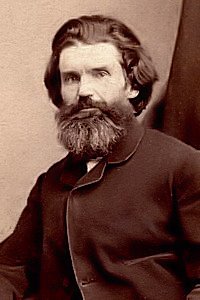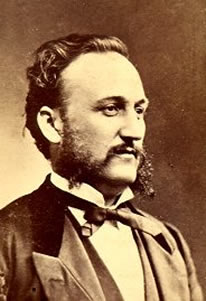Crer e Observar (Ginsburg)
“Trust and Obey”
→ Este hino dá uma explicação simples, clara de viver a vida Cristã. A expressão do título foi usada em um testemunho de um culto de oração, numa cruzada evangelística em Brockton, Massachusetts, por Dwight Lyman Moody. Um jovem se levantou e explicou como a doutrina cristã havia ficado claro. Mas ele terminou dizendo, “eu não estou completamente certo – mas eu vou confiar, e eu vou obedecer”. Daniel Towner que estava neste encontro anotou as palavras, e as deu a John H. Sammis que desenvolveu a letra desse hino.
→ Homem de negócios e funcionário do YMCA em Logansport, Indiana. Sammis assistiu aos Seminários Teológicos de McCormick e Lane ordenados por um ministro presbiteriano em 1880. Ele serviu em Glidden, Iowa, Indianapolis, Indiana, Grandhaven, Michigan, Red Wing, Minnesota; e Sullivan, Indiana. E o resto de sua carreira ensinou no Instituto Bíblico de Los Angeles.
Letra: John Henry Sammis, in Hymns Old and New (Chicago, Illinois: Fleming H. Revell, 1887). Tradução do inglês para o português por Salomão Luiz Ginsburg, (1867-1927).
Música: Daniel Brink Towner, (1850-1919). [ ![]() —
— ![]() —
— ![]() ].
].
Músicas Alternativas:
“Trust and Obey (Werdebaugh)”, Scott Werdebaugh, 2018. [ ![]() —
— ![]() —
— ![]() ].
].
Crer e Observar (Borges)
“Trust and Obey”
→ Este hino dá uma explicação simples, clara de viver a vida Cristã. A expressão do título foi usada em um testemunho de um culto de oração, numa cruzada evangelística em Brockton, Massachusetts, por Dwight Lyman Moody. Um jovem se levantou e explicou como a doutrina cristã havia ficado claro. Mas ele terminou dizendo, “eu não estou completamente certo – mas eu vou confiar, e eu vou obedecer”. Daniel Towner que estava neste encontro anotou as palavras, e as deu a John H. Sammis que desenvolveu a letra desse hino.
→ Homem de negócios e funcionário do YMCA em Logansport, Indiana. Sammis assistiu aos Seminários Teológicos de McCormick e Lane ordenados por um ministro presbiteriano em 1880. Ele serviu em Glidden, Iowa, Indianapolis, Indiana, Grandhaven, Michigan, Red Wing, Minnesota; e Sullivan, Indiana. E o resto de sua carreira ensinou no Instituto Bíblico de Los Angeles.
Letra: “Trust and Obey“, John Henry Sammis, in Hymns Old and New (Chicago, Illinois: Fleming H. Revell, 1887). Tradução do inglês para o português por Daniel Borges, 2004.
Música: Daniel Brink Towner, (1850-1919). [ ![]() —
— ![]() —
— ![]() ].
].
Músicas Alternativas:
“Trust and Obey (Werdebaugh)”, Scott Werdebaugh, 2018. [ ![]() —
— ![]() —
— ![]() ].
].
[ Translation by Ginsburg see also in Cyberhymnal and English ]
Confia no Senhor Crer e Observar (Ginsburg)
Confia no Senhor
“Trust in the Lord”
Letra: Maria Beatriz da Silva Borges, 2006. Arranjos e métrica por Daniel Borges, 2007.
Música: “Solid Rock”, William Batchelder Bradbury, 1863. [ ![]() —
— ![]() —
— ![]() ].
].
[ See in Cyberhymnal ]
Blessed Assurance Crer e Observar (Borges)
Blessed Assurance
“Que Segurança”
Letra: Fanny Jane Crosby, 1873. My friend, Mrs. Joseph F. Knapp, composed a melody and played it over to me two or three times on the piano. She then asked what it said. I replied, Blessed assurance, Jesus is mine! This hymn was sung in the Academy Award winning movies Places in the Heart (1984) & Trip to Bountiful (1985). Based on the number of hymnals in which it appears (over 850), this song is Fanny’s most popular work.
Música: “Assurance”, Phoebe Palmer Knapp, 1873; tradução do inglês para o português por Daniel Borges, 2009. [ ![]() —
— ![]() —
— ![]() ].
].
→ Though blinded by an incompetent doctor at six weeks of age, she wrote over 8,000 hymns. About her blindness, she said: “It seemed intended by the blessed providence of God that I should be blind all my life, and I thank him for the dispensation. If perfect earthly sight were offered me tomorrow I would not accept it. I might not have sung hymns to the praise of God if I had been distracted by the beautiful and interesting things about me”.
→ In her lifetime, Fanny Crosby was one of the best known women in the United States. To this day, the vast majority of American hymnals contain her work. When she died, her tombstone carried the words, “Aunt Fanny” and “Blessed assurance, Jesus is mine.
![]()
[ See Potuguese in Cyberhymnal,
and in Danny’s Home Page: by Daniel Borges, by George Benjamim Nind
and see also English in Cyberhymnal]
Anseio Trabalhar Por Meu Senhor Confia no Senhor
Anseio Trabalhar Por Meu Senhor
“I Want to Be a Worker“
Letra & Música: “I Want to Be a Worker”, Isaiah Baltzell, 1880; tradução do inglês para o português por Daniel Borges, 2009. [ ![]() —
— ![]() —
— ![]() ].
].
[ See in Cyberhymnal see also Inglês ]
Aceita a Mim Senhor Blessed Assurance
Aceita a Mim, Senhor
“Jesus, My Lord, to Thee I Cry”
Letra: “Take Me as I Am”, Eliza H. Hamilton, Em “A Selection of Hymns, Supplement to the Methodist Pocket Hymn Book, by John Wilson & Daniel Hitt” (New York: 1808); tradução do inglês para o português por Daniel Borges, 2004.
Música: Ira David Sankey (1840-1908). [ ![]() —
— ![]() —
— ![]() ].
].
[ See in Cyberhymnal see also English ]
Abra Meus Olhos Senhor Anseio Trabalhar por Meu Senhor
Abra Meus Olhos, Senhor
“Open My Eyes, That I May See”
Letra & Música: “Open My Eyes”, Clara Harriet Jones Scott, in Best Hymns No. 2 by Elisha Albright Hoffman (1839–1929) & Harold F. Sayles (Chicago, Illinois: Evangelical Publishing, 1895); tradução do inglês para o português por Daniel Borges, 2005. [ ![]() —
— ![]() —
— ![]() ]. Some hymnals incorrectly give the author as Charles Scott, and some hymnals append additional verses by Frederick Pitman Morris (1872–1950).
]. Some hymnals incorrectly give the author as Charles Scott, and some hymnals append additional verses by Frederick Pitman Morris (1872–1950).
[ See in Cyberhymnal see also English ]
Voltar ao Índice Aceita a Mim Senhor











